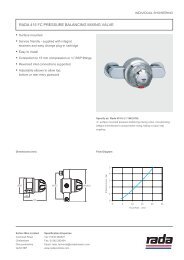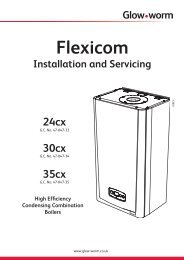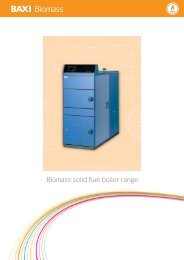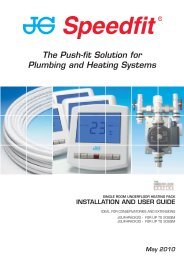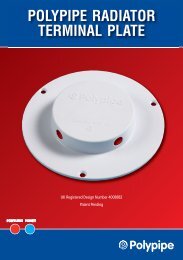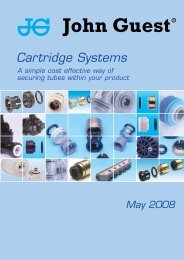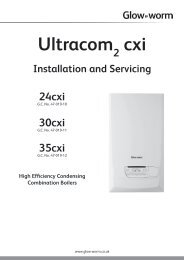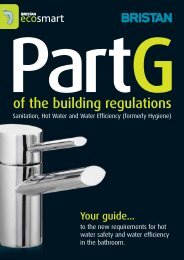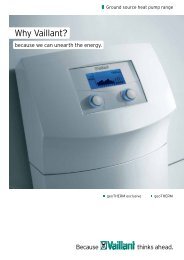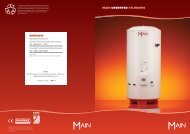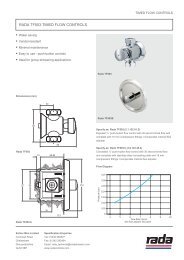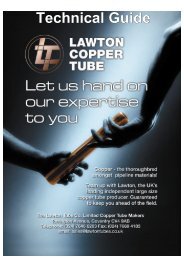Hep20 Technical Handbook
Hep20 Technical Handbook
Hep20 Technical Handbook
Create successful ePaper yourself
Turn your PDF publications into a flip-book with our unique Google optimized e-Paper software.
Hep 2<br />
O ® Design Considerations<br />
Systems Planning<br />
Cabling Through Joists<br />
The 1992 Building Regulations<br />
Approved Document A allows for<br />
pipework to be installed within joists<br />
by one of two methods, notching or<br />
drilling. Traditionally joists have been<br />
notched and the pipework laid in<br />
because the rigidity of the pipe does<br />
not easily allow for any other method<br />
of installation. This means that the<br />
pipework must be installed before<br />
flooring boards are laid.<br />
Rigid pipework has a number of<br />
disadvantages:<br />
•<br />
the plumber has to work on<br />
open joists increasing risk of<br />
accident or injury.<br />
•<br />
the plumber will have to return<br />
after floors are laid to connect<br />
radiators, etc.<br />
•<br />
the plumber often finds that the<br />
tails originally installed have been<br />
moved by other tradesmen<br />
thereby causing extra work to<br />
reposition pipework correctly for<br />
radiators.<br />
Flexible pipework<br />
Hep 2 O ® flexible pipework cabled<br />
through joists means that it can be<br />
installed by working from below<br />
allowing exact positioning of ‘tails’<br />
through floor boarding.<br />
As flooring can be laid prior to the<br />
plumber carcassing from below this<br />
will progress the building schedule as<br />
other trades can work on the floor<br />
above e.g. to form studwork, etc.<br />
Carcassing at a later stage in the<br />
construction programme is also<br />
more pleasant as the building is<br />
likely to be weatherproof.<br />
Flexible pipework also has further<br />
advantages:<br />
•<br />
cabled pipework can more easily<br />
utilise continuous runs of<br />
pipework.<br />
•<br />
dry runs are not necessary as the<br />
pipe can be cut and joints made<br />
in situ.<br />
• there is less possibility of<br />
puncturing the pipe with nails<br />
used for fixing the flooring<br />
boards, and there is no need to<br />
use protective devices such as<br />
‘joist clips’.<br />
• Hep 2 O® can be trimmed to<br />
length and the natural flexibility<br />
used to overcome any misalignment.<br />
• when Hep 2 O® is cabled through<br />
joists it can be easily positioned<br />
to allow for the installation of<br />
thermal insulation if required.<br />
Pumps and valves<br />
Where Hep 2 O ® is connected to<br />
pumps, valves and similar devices<br />
consideration should be given to<br />
adequately supporting the item in<br />
question (bearing in mind the<br />
rotatability of the Hep 2 O ® joint).<br />
Equipment should therefore not be<br />
suspended from the pipe without<br />
adequate support.<br />
Enhanced site safety and less<br />
risk to health<br />
Installing the plumbing system below<br />
a completed floor means that site<br />
safety is enhanced and the plumber<br />
is not exposed to the danger of<br />
falling or the discomfort of kneeling<br />
on open joists. Other trades also<br />
working below are protected from<br />
falling tools, molten solder, gas<br />
bottles etc.<br />
The unique Hep 2 O ® fittings ensure<br />
effective, high performance pipe<br />
jointing without the use of a naked<br />
flame.<br />
Safety from fire, especially in<br />
restricted spaces, is therefore<br />
greatly increased and the working<br />
environment is improved.<br />
As there is no need for flux and<br />
solder, any potential contamination<br />
of water supplies is eliminated.<br />
Push-fit jointing also has further<br />
safety advantages:<br />
•<br />
no naked flame means that<br />
precautions such as obtaining a<br />
‘hot work’ permit, having a fire<br />
extinguisher readily available, and<br />
remaining on site for a while<br />
after jointing are not necessary.<br />
•<br />
no risk of infringement of Health<br />
and Safety recommendations<br />
applicable to some brands of flux,<br />
such as the means to control<br />
exposure to noxious fumes when<br />
working in a confined space, or<br />
the use of eye protection (where<br />
appropriate).<br />
•<br />
after jointing the fitting is clean<br />
and safe to touch, whereas after<br />
soldering, the joint is hot and flux<br />
traces have to be removed.<br />
•<br />
as no solvents are used in<br />
jointing, the system can be tested<br />
as soon as the installation is<br />
finished.<br />
64



